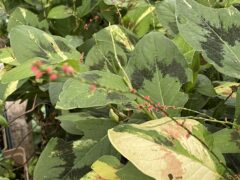
Russian sage
Perovskia atriplicifolia/Perovskia hybrid
Perennial Plant Association 1995 Perennial Plant of the Year! Perovskia atriplicifolia ‘Little Spire’ is a … Continued
Drought-tolerant and drought-resistant plants may still need supplemental water from time to time, but they can survive periods of dryness without dying.
Drought-resistant plants like cactus, hens and chicks, and sedums can go for very long periods without water and do not tolerate poorly drained locations. Drought-resistant tropical plants grown indoors in winter like cactus, Sansevieria, Echeveria, and other succulents sometimes fail due to overwatering.
Drought-tolerant plants grow in many textures and sizes and have different adaptations that help them get through periods of drought:
The latter two types of plants are drought tolerant once established because any new planting, regardless of drought tolerance, needs to be watered during the first growing season to allow roots to reach the depths needed to access moisture during dry periods.
It’s also important to note that survival may not mean that the plant will look its best during this time. Watering weekly for a longer period of time will result in the best-looking gardens with the highest tolerance for drought. During the hottest, dryest times in summer, watering deeply twice a week is recommended. These less frequent waterings will encourage root systems to expand, making it easier for plants to access moisture when their environment is dry.
Winter drought has become a bigger problem in recent years as snowfall declines. Evergreen plants are especially vulnerable during winter drought because their foliage continues to shed moisture while dormant deciduous plants have shed their leaves and can conserve moisture in woody stems and underground. Watering shrubs and trees in winter on days when the temperature allows (above freezing) will help ensure their healthy return in spring.
Here are some drought-tolerant and drought-resistant plants to grow—

Perovskia atriplicifolia/Perovskia hybrid
Perennial Plant Association 1995 Perennial Plant of the Year! Perovskia atriplicifolia ‘Little Spire’ is a … Continued

Persicaria virginiana var. filiformis 'Painter's Palette'
Grown primarily for its attractive, variegated foliage, plants form a spreading foliage mound 18-24” tall … Continued

Phalaris arundinacea 'Strawberries and Cream'
18″ colorfully tricolored leaves are variegated with white, green and pink. This grass spreads aggressively, … Continued

Phemeranthus {Talinum} calycinus
This native perennial most often occurs in rocky soils and is often found growing in … Continued

Philodendron bipinnatifidum 'Hope'
This Philodendron doesn’t climb like some varieties, and is a smaller hybrid of the big … Continued

Philodendron bipinnatifidum
‘Shangri-la’ is a compact split-leaf philodendron with lime-green veining. A dense, bushy tropical that develops … Continued

Philodendron hederaceum 'Variegata'
Classic green heart leaf Philodendron but with a stunning golden variegation.

Phlox drummondii
Loads of single blooms in clusters atop 6-8″ plants all summer long. Flowers range in … Continued

Phlox paniculata 'Blue Paradise'
Among the bluest, flower color changes markedly according to different light conditions. The flowers are … Continued

Phlox paniculata 'Jeana'
2024 Perennial Plant of the Year Found by and named after Jeana Prewitt of Nashville, … Continued

Phlox paniculata 'Red Riding Hood'
Vivid clusters of fragrant, cherry-red flowers from mid thru late summer. This compact variety attracts … Continued

Phlox subulata
Showy spring perennials produce vibrant carpets of bloom in very early spring, right when we’re … Continued